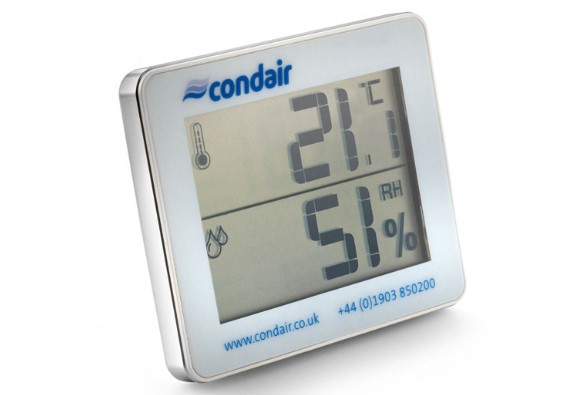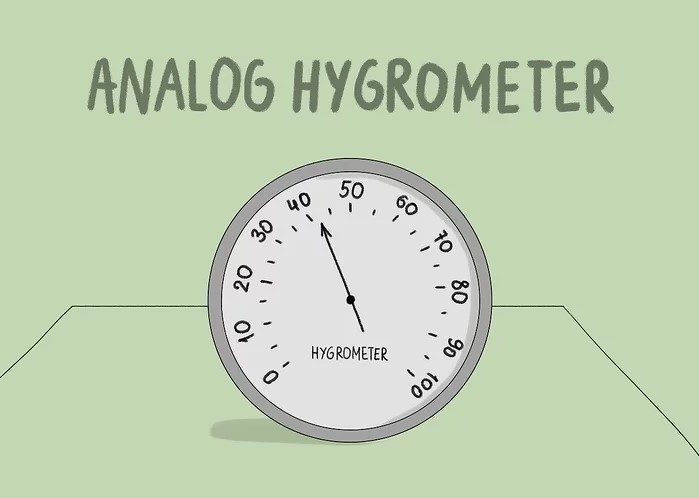Humidity, the amount of water vapor in the air, plays a crucial role in our comfort and well-being. In the UK, with its variable climate, maintaining optimal indoor humidity levels is essential for a healthy living environment. High humidity can lead to mold growth, musty odors, and respiratory problems, while low humidity can cause dry skin, itchy eyes, and static electricity.
In this guide, we’ll explore the importance of measuring humidity, the ideal indoor humidity levels, and the various methods and tools you can use to measure and control humidity in your UK home. Understanding humidity, measuring it accurately, and taking appropriate steps to regulate it can create a more comfortable and healthy home.
Why Measure Humidity?
Monitoring indoor humidity levels is important for several reasons:
- Health benefits: Maintaining proper humidity levels can help prevent respiratory problems, allergies, and skin irritations. High humidity can promote mold growth, which can trigger asthma attacks and other respiratory issues. Low humidity can dry out mucous membranes, making them more susceptible to infections.
- Mold and mildew prevention: Mold and mildew thrive in damp environments. By keeping humidity levels in check, you can reduce the risk of these harmful organisms growing in your home.
- Protection of belongings: High humidity can damage furniture, artwork, books, and other valuables. Low humidity can cause wood to shrink and crack.
- Energy efficiency: Maintaining optimal humidity levels can improve the efficiency of your heating and cooling systems. High humidity can make it more difficult to cool your home, while low humidity can increase heating costs.
What Are Ideal Humidity Levels for Homes?
Humidity is the amount of moisture in the air. Indoor humidity levels are crucial to maintaining a healthy living space. Generally, the ideal indoor humidity level for homes should range between 30% and 50%.
Optimal Indoor Humidity Levels
Keeping your home’s humidity within the recommended range ensures that the air is not too dry or too moist. At 30-50%, your home’s atmosphere is conducive to comfortable living, preventing both property damage and health concerns.
Humidity & Health
Humidity levels that are too high can encourage the growth of dust mites, mold, and bacteria, which thrive in moist conditions. These allergens can trigger respiratory problems such as asthma, and allergies, and contribute to a general feeling of discomfort.
On the other hand, low humidity can lead to dry skin, nosebleeds, irritated airways, and increased susceptibility to colds and respiratory infections. Maintaining the right humidity levels is vital for your respiratory health.
Humidity & Property
Excessive humidity can cause damage to your home’s structure and furnishings. High humidity can lead to condensation on windows, resulting in water damage, peeling paint, and mold formation on walls and ceilings. Wooden furniture can warp and rot, and electronics may become damaged.
On the flip side, low humidity can cause wooden floors and furniture to crack and warp, as dry air pulls moisture out of natural materials. Keeping humidity levels balanced helps to preserve both your home and its contents.
How to Measure Humidity in Your Home
To keep your home’s humidity at a comfortable level, it’s essential to measure it regularly. Fortunately, there are several methods available, ranging from simple DIY techniques to advanced digital devices.
Digital Hygrometers
A digital hygrometer is the most accurate and reliable tool for measuring humidity. It provides real-time readings of your home’s relative humidity (RH) and is easy to use. You can find many affordable models online or in hardware stores in the UK. Some digital hygrometers also come with additional features like temperature readings, which can be useful for climate control.
Where to Place a Hygrometer: For the most accurate readings, place the Hygrometer in a room where humidity levels are of concern (e.g., the bathroom or kitchen). Avoid placing it near heat sources like radiators or in direct sunlight, as this can skew the results.

Image source: condair.co.uk
Analog Hygrometers
Analog hygrometers, while less common today, are still an option for those who prefer non-digital solutions. They work based on mechanical changes in materials that expand or contract depending on the humidity levels. However, analog hygrometers are less accurate than their digital counterparts and may require calibration from time to time.

Image source: wikihow.com
Smart Devices & Apps
With the rise of smart home technology, it’s possible to monitor your home’s humidity remotely. Smart thermostats, weather stations, and other home automation devices often come with built-in hygrometers. These devices not only measure humidity but can also help you control it by automatically adjusting temperature and ventilation based on your home’s conditions.
Many smart devices can be integrated with mobile apps, allowing you to check your home’s humidity levels from your smartphone, wherever you are.

Image source: trakkitgps.com
DIY Methods
If you don’t have a hygrometer, you can use simple DIY methods to estimate humidity levels:
- The Ice Cube Test: Place a few ice cubes in a glass of water and leave it in a room for five minutes. If condensation forms on the outside of the glass, the humidity level is high. If there’s no condensation, the air is likely too dry.
- Observation: Pay attention to condensation on windows and other symptoms mentioned earlier.

Image source: wikihow.com
Common Signs of Incorrect Humidity Levels
Before you begin measuring humidity, it’s important to recognize the signs of imbalanced humidity levels in your home.
Symptoms of High Humidity
- Condensation on Windows: This is a common sign of excess moisture. If you notice droplets forming on windows, especially during cold weather, your home likely has high humidity.
- Musty Smells: High humidity encourages mold growth, which often produces a musty, damp smell.
- Visible Mold: Mold can appear in areas with poor ventilation, such as bathrooms, kitchens, and basements. It often grows on walls, ceilings, and around windows.
Symptoms of Low Humidity
- Dry Skin and Hair: If the air in your home is too dry, your skin may feel tight, and your hair may become brittle.
- Static Electricity: Dry air increases the likelihood of static electricity, leading to small shocks when you touch objects or other people.
- Cracked Wooden Furniture: If your wooden furniture or floors are cracking or warping, low humidity might be to blame.
UK-Specific Factors
UK homes are particularly prone to humidity issues due to the country’s temperate maritime climate. Older homes, especially those with poor insulation, are at risk of dampness and condensation. Additionally, frequent rainfall and cool temperatures can exacerbate humidity problems, especially during the winter months.
How to Control Humidity Levels
Once you’ve measured the humidity in your home, the next step is to adjust it to a comfortable level.
Solutions for High Humidity
- Dehumidifiers: A dehumidifier is one of the most effective ways to lower indoor humidity. These devices pull moisture from the air and collect it in a tank. Dehumidifiers come in different sizes, so choose one based on the size of the room and the severity of the humidity problem.
- Ventilation: Proper ventilation is key to controlling moisture levels. Ensure that your home has sufficient ventilation, especially in kitchens, bathrooms, and laundry rooms. Installing extractor fans or opening windows regularly can help.
- Damp-Proofing Solutions: For homes with persistent damp problems, professional damp-proofing services can be a long-term solution. UK building regulations often recommend damp-proofing measures, especially in older buildings.
Solutions for Low Humidity
- Humidifiers: To increase humidity, you can use a humidifier. These devices add moisture to the air and come in various models, such as cool mist and warm mist humidifiers.
- Natural Methods: You can increase humidity naturally by placing bowls of water around your home or introducing houseplants, which release moisture into the air as they grow.
Monitoring and Maintaining Humidity Levels
To keep your home’s humidity levels in check year-round, regular monitoring is essential.
Seasonal Changes
UK weather changes throughout the year can affect indoor humidity. During winter, cold air can hold less moisture, leading to dry conditions indoors. In summer, humidity levels can rise due to warmer temperatures. Adjust your use of humidifiers and dehumidifiers based on seasonal changes to keep your home comfortable.
Regular Maintenance Tips
Check your home’s humidity levels regularly, especially after significant weather changes. Ensure that your humidifiers and dehumidifiers are cleaned and maintained properly to prevent mold or bacteria growth.
Smart Home Integration
Using smart home devices that automatically monitor and adjust humidity levels can make the process seamless. You can set up these devices to activate humidifiers or dehumidifiers based on real-time data, ensuring your home’s climate is always optimal.
Conclusion
Maintaining optimal indoor humidity levels is essential for a healthy and comfortable living environment. By understanding humidity, measuring it accurately, and taking appropriate steps to regulate it, you can create a home that is conducive to your well-being.
Remember to monitor humidity levels regularly and adjust your strategies as needed to ensure a healthy and comfortable living space.
Frequently Asked Questions (FAQs)
Humidity in the UK is typically measured using a hygrometer, which can be either digital or analog. These devices give real-time readings of the moisture content in the air. Smart home devices and weather stations with built-in hygrometers are also becoming popular in UK homes.
The best way to measure humidity is by using a digital hygrometer. These devices are accurate, easy to use, and provide quick readings of your home’s humidity. Place the hygrometer in areas like the bathroom or kitchen, where moisture levels tend to fluctuate.
A good indoor humidity level for a UK home is between 30% and 50%. This range ensures comfort, prevents mold growth, and avoids issues like dry air or damage to furniture and electronics.
You don’t need to manually calculate indoor humidity. Use a hygrometer to measure the relative humidity directly. If you don’t have one, you can estimate using simple DIY methods like the ice cube test (place ice in a glass of water; if condensation forms outside the glass, humidity is high).
